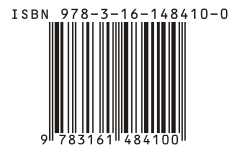ISBN Number

A 13-digit ISBN, 978-3-16-148410-0, as represented by an EAN-13 bar code
|
|
| Acronym | ISBN |
|---|---|
| Introduced | 1970 |
| Managing organisation | International ISBN Agency |
| No. of digits | 13 (formerly 10) |
| Check digit | Weighted sum |
| Example | 978-3-16-148410-0 |
| Website | www |
The International Standard Book Number (ISBN) is a unique numeric commercial book identifier.
An ISBN is assigned to each edition and variation (except reprintings) of a book. For example, an e-book, a paperback and a hardcover edition of the same book would each have a different ISBN. The ISBN is 13 digits long if assigned on or after 1 January 2007, and 10 digits long if assigned before 2007. The method of assigning an ISBN is nation-based and varies from country to country, often depending on how large the publishing industry is within a country.
The initial ISBN configuration of recognition was generated in 1967 based upon the 9-digit Standard Book Numbering (SBN) created in 1966. The 10-digit ISBN format was developed by the International Organization for Standardization (ISO) and was published in 1970 as international standard ISO 2108 (the SBN code can be converted to a ten digit ISBN by prefixing it with a zero).
Occasionally, a book may appear without a printed ISBN if it is printed privately or the author does not follow the usual ISBN procedure; however, this can be rectified later.
Another identifier, the International Standard Serial Number (ISSN), identifies periodical publications such as magazines; and the International Standard Music Number (ISMN) covers for musical scores.
The Standard Book Numbering (SBN) code is a 9-digit commercial book identifier system created by Gordon Foster, Emeritus Professor of Statistics at Trinity College, Dublin, for the booksellers and stationers WHSmith and others in 1965. The ISBN configuration of recognition was generated in 1967 in the United Kingdom by David Whitaker (regarded as the "Father of the ISBN") and in 1968 in the US by Emery Koltay (who later became director of the U.S. ISBN agency R.R. Bowker).
The 10-digit ISBN format was developed by the International Organization for Standardization (ISO) and was published in 1970 as international standard ISO 2108. The United Kingdom continued to use the 9-digit SBN code until 1974. ISO has appointed the International ISBN Agency as the registration authority for ISBN worldwide and the ISBN Standard is developed under the control of ISO Technical Committee 46/Subcommittee 9 TC 46/SC 9. The ISO on-line facility only refers back to 1978.
...
Wikipedia
